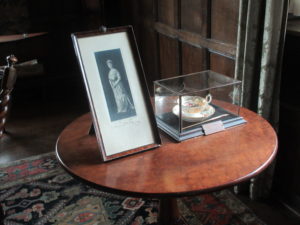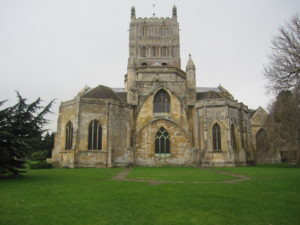So much to discover in Tewkesbury, with its imposing Abbey in the heart of the town and almost 400 listed buildings.
We visited here while staying nearby as we were keen to see the Abbey as well as the town’s renowned medieval black and white buildings and the hidden charms of narrow alleyways. The surrounding rivers and flood plain have prevented the old town from expanding and therefore its long, thin profile has hardly changed since the middle ages. Its half timbered Tudor buildings, overhanging upper-storeys and ornately carved doorways have retained their originality.
We managed to find a space to park near the Abbey (visitors car park). Being February, it was relatively quiet and entry is free.
Tewkesbury Abbey has dominated the skyline for over 900 years with its fine Norman towers and great examples of medieval architecture, tombs and monuments as well as it’s many stained glass windows. The Abbey was consecrated in 1121 as the church to the Benedictine Abbey of Tewkesbury.
The Abbey actually boasts the largest Norman Tower in existence measuring 45 metres high and 14 metres square. There is reference to a wooden spire which collapsed in 1559. It’s not really known what bells were in the tower at the time but there was a small, detached tower in the churchyard. When the monastery was dissolved in 1539, Henry VIII sold eight bells to the parish for £142. By the early 1600s, there were only four bells. An extra bell was added in 1612.
I picked up a guide leaflet to help steer me through this historic church. The lectern caught my eye as it was undergoing its annual clean and polish. It was interesting talking to the person doing this and the reasons for using specific tools/polish for the job. I remember my grandmother using ‘Brasso’ for cleaning, but apparently this is too abrasive. The Lectern is 19th century and the figures around the base are the four evangelists.
The Font has a 13th century base and a 14th century bowl. In Victorian times, an ornate wooden canopy was fitted.
The Nave has 14 huge, Norman columns and mason’s marks can be seen on some of the pillars.
The 15 Roof Bosses on the centre rib represent the life of Christ and angels can be seen playing instruments on both sides. In medieval times, the Abbey was partitioned off just below the pulpit, reserving one half for the monastery and the other for the townspeople.
When you look up (The Quire) you see the sun – an emblem of the House of York put there as a memorial to their victory over the House of Lancaster in the Battle of Tewkesbury, 1471. When you look down you can see the brass plaque marking the burial place of Edward, the Lancastrian Prince of Wales.
The High Altar is made of Purbeck marble and was hidden from sight in Cromwell’s day by being sawn in half and laid on the seats in the porch. There is a good collection of Misericords (carved wooden resting ledges) where monks would lean to worship.
In a prominent position for all to see, is the Milton Organ with 68 speaking stops and 4,611 pipes, built in 1631 for Magdalen College, Oxford. It was sold to the Abbey in 1737 and restored in 1997.
The Denny Windows are two modern windows, designed and made by Tom Denny in 2002. They mark the 900th anniversary of the Benedictine’s coming to Tewkesbury
Famous for its medieval stained glass, you will see these in the seven quire windows. There is also a fine collection of Victorian stained glass set into the walls of the north and south aisles.
After a grand tour, taking in so much, I ended up at the Abbey Shop in St James’ Chapel which is partly 12th century and part 14th century – and where the Duke of Somerset is buried beneath the till!
A painted screen, by Thomas Gamier-Parry is at the end of the shop which was used as a reredos behind the High Altar. The shop has items ranging from crafts, cards, gifts, jewellery and music.
Finally, we thought we would make our way to the ‘Touching Souls tea Room’ for a cup of tea. It is run by volunteers and serves home-made soup, baked potatoes, sandwiches and home-made cakes and scones.
We later strolled along near the Abbey to a row of magnificent 15th century timber-framed buildings and saw the John Moore Museum, established in 1980. The collection here was created in memory of the writer and naturalist, John Moore. It is home to an extensive natural history collection with specimens of birds and mammals native to the Gloucestershire countryside, woodlands, farmland and wetlands.
Just a few doors away is the Merchant’s House, a two storey building, restored and furnished as a Tudor shop and home.
The museum is a first point of call to visit the old Baptist Chapel (can buy 2 in 1 tickets for both). The chapel was once a late three bay Medieval Hall house, later converted for use as a non-conformist meeting house. It had a fire in the middle of the building and the family slept on one of the two balconies upstairs. Cattle may have been kept downstairs! (reminds me of dwellings in Northern Spain).
In 1623, the building is thought to have been given to the Baptists as a meeting place. It was ‘modernised’ in the 18th century to make it more suitable for its use and a minister’s room was added along with a vaulted ceiling, tall windows and a baptistery.
In 1805, a larger chapel was opened in town and the old one fell into disuse. Tewkesbury Borough Council acquired the Court and Chapel in 1976 and restored them.
I ventured up the narrow alley to peek into the old chapel, and met a woman with whom I took up a conversation. It turned out she was born in the house in front of the alley, later moved away, then returned to a cottage further down the alley, before you reach the old graveyard. She told me all about her family then the Abbey (for which she wrote a thesis) and ended up telling us about the ‘secret garden’ in the Abbey and how to get in there. It was developed by soldiers after the war, and now belongs to the Abbey Lawn Trust. Access is free from the street. It is a lovely little niche with a unique angle view of the Abbey. In summer, it must be quite attractive and seems popular with the birds (feathered kind)!
It was a wonderful opportunity to gain extra insight and knowledge of not only the Abbey but it’s locality, from someone who spent most of her life there.
When I was in the Abbey shop I picked up a small recipe book, ‘Flavours of Gloucestershire & The Cotswolds’ and it wasn’t until I returned home that I read about Tewkesbury Mustard Balls!
There was a legend that Tewkesbury Mustard Balls, covered in gold leaf, were presented to Henry VIII when he visited the town in 1535.
Tewkesbury’s women gathered the ingredients from the fields and river banks, then a cannonball in an iron mortar was used to crush the mustard grain to a fine flour. It was then sieved to produce a fineness and purity, making it much sought after throughout England.
To make the condiment hotter, horseradish (a common weed in the area) was used but it caused a lot of suffering. While preparing the root, before being soaked in cider or cider vinegar, the fumes caused a painful irritant to the eyes.
The precise recipe has been lost but the ingredients of local grown mustard seed and horseradish infusion was formed into balls and left to dry on a board. The customer would then cut off as much as was required, steep it in water, milk, cider or cider vinegar until it was workable. What resulted, was thick and pungent. This type of mustard was familiar to William Shakespeare, and in ‘Henry IV’, he gave the following words to Falstaff, describing Poins as having ‘wit as thick as Tewkesbury mustard.’
The manufacturing of Tewkesbury mustard died out at the beginning of the 19th century (coincidental with Mr Coleman of Norwich inventing his new process for producing mustard flour). However, tradition is restored as a cottage industry and mustard balls are produced to order and on special occasions, such as the re-enactment of the Battle of Tewkesbury held annually in July.
Tewkesbury Mustard goes down well with Sirloin Steaks, I understand!










